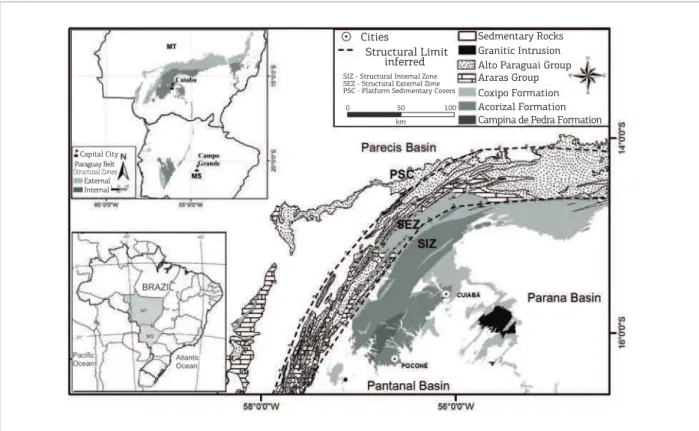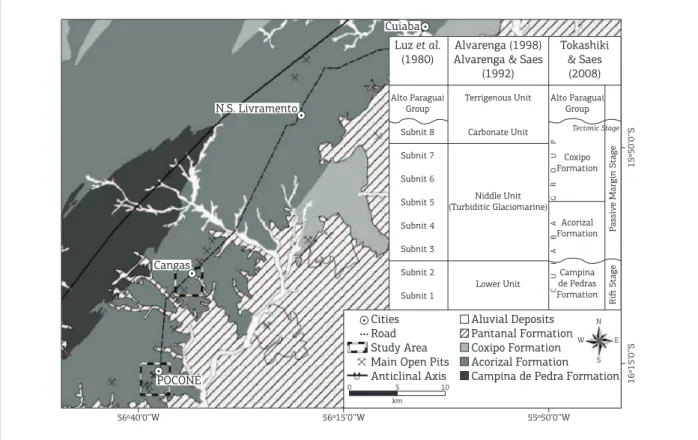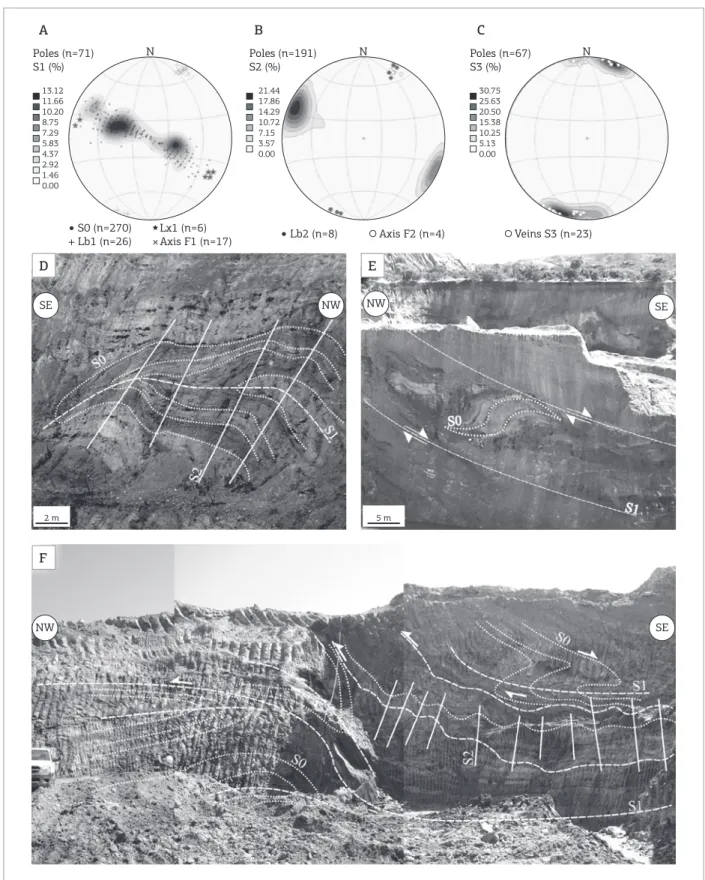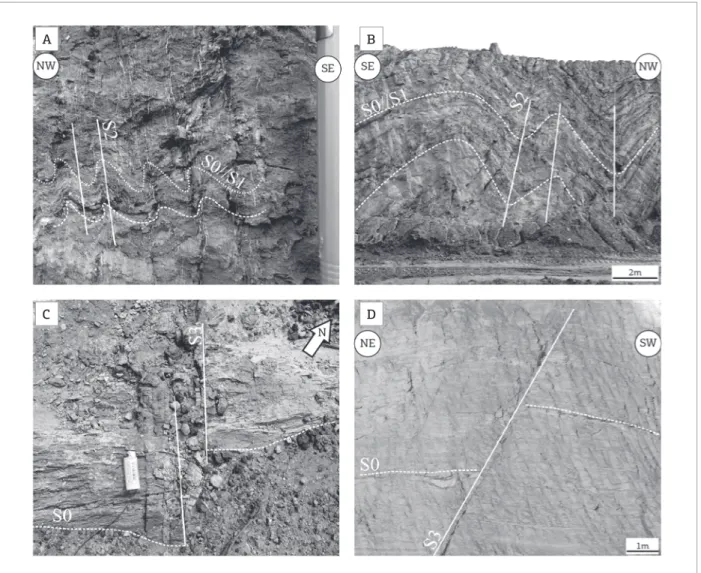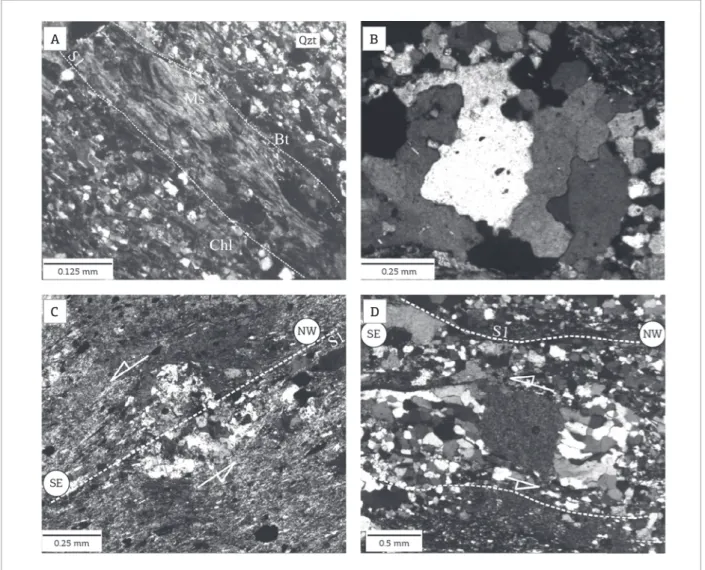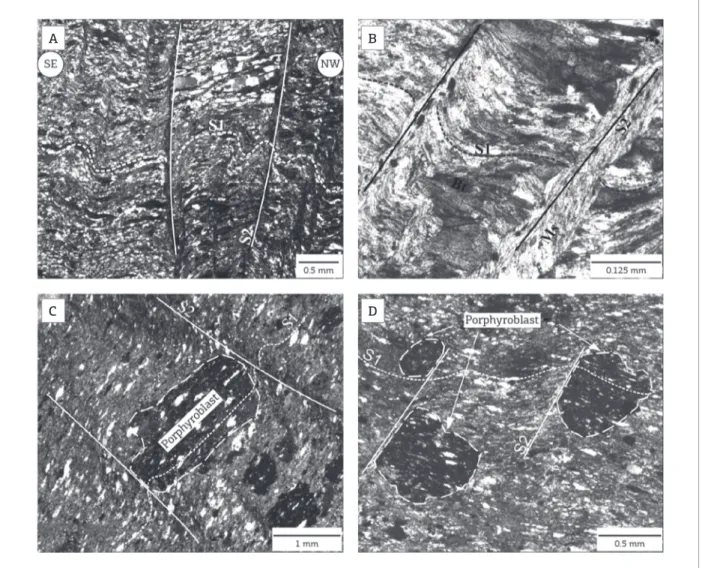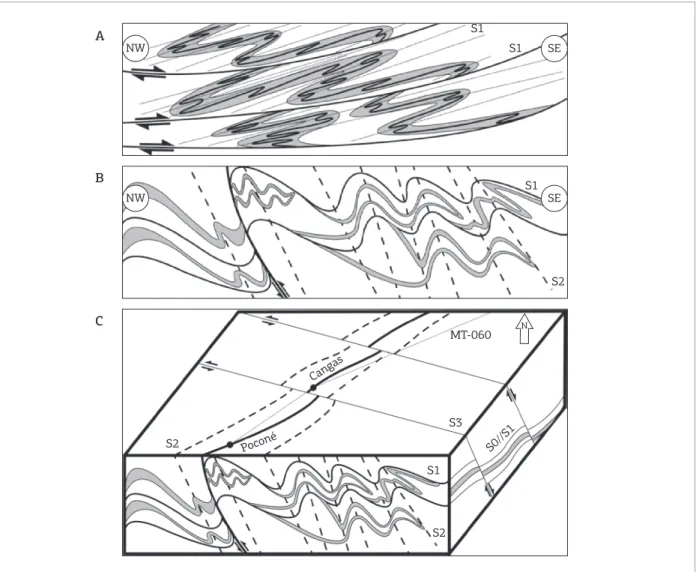1Geoscience Postgraduate Program, Institute of Exact and Earth Sciences, Universidade Federal do Mato Grosso – UFMT, Cuiabá (MT), Brazil. Email: brunovasc@gmail.com 2Department of General Geology, Institute of Exact and Earth Sciences, Universidade Federal do Mato Grosso – UFMT, Cuiabá (MT), Brazil. Email: asruiz@gmail.com 3Department of Mineral Resources, Institute of Exact and Earth Sciences, Universidade Federal do Mato Grosso – UFMT, Cuiabá (MT), Brazil. Email: prof.jmatos@gmail.com 4National Institute of Science and Geosciences Technology of the Amazon – GEOCIAM, Universidade Federal do Pará, Belém (PA), Brazil.
5Research Group of Crustal Evolution and Tectonics – Guaporé (MT), Brazil.
*Corresponding author.
Manuscrito ID: 30179. Recebido em: 10/10/2014. Aprovado em: 05/02/2015. ABSTRACT: Several deformation models have been proposed for the Paraguay Belt, which primarily difer in the number of phases of deformation, direction of vergence and tectonic style. Structural features presented in this work indicate that the tectonics was dom‑ inated by low dip thrust sheets in an initial phase, followed by two progressive deformation phases. he irst phase of deformation is characterized by a slate cleavage and axial plane of isoclinal recum‑ bent folds with a NE axial direction, with a recrystallization of the minerals in the greenschist facies associated with horizontal shear zones with a top‑to‑the‑SE sense of movement. he second stage shows vergence towards the NW, characterized by crenulation cleav‑ age axial plane to F2 open folds over S0 and S1, locally associated with reverse faults. he third phase of deformation is characterized by subvertical faults and fractures with a NW direction showing sinistral movement, which are commonly illed by quartz veins. he collec‑ tion of tectonic structures and metamorphic paragenesis described indicate that the most intense deformation at the deeper crustal level, greenschistfacies, occurred during F1, which accommodated signii‑ cant crustal shortening through isoclinal recumbent folds and shear zones with low dip angles and hangwall movement to the SE, in a thin‑skinned tectonic regime. he F2 deformation phase was less intense and had a brittle to ductile behavior that accommodated a slight shortening through normal open subvertical folds, and reverse faults developed in shallower crustal level, with vergence towards the Amazonian Craton. he third phase was less pervasive, and the short‑ ening was accommodated by relief subvertical sinistral faults. KEYWORDS: gondwana agglutination; brasiliano cycle; structural analysis; microtectonic; microstructures.
RESUMO: Vários modelos deformacionais foram propostos para o Cin‑ turão Paraguai, diferindo principalmente quanto ao número de fases de deformação, sentido da vergência e estilo tectônico. Feições estruturais apresentadas neste trabalho indicam tectônica dominada por escamas de baixo mergulho na fase inicial, seguida por duas fases deformacionais progressivas. A primeira fase de deformação é caracterizada por uma cli‑ vagem ardosiana, plano axial de dobras isoclinais recumbentes de direção axial NE, com recristalização de minerais da fácies xisto verde, associada a zonas de cisalhamento horizontais com movimentação de topo para SE. A segunda fase mostra vergência para NW, caracterizada por uma clivagem de crenulação plano axial de dobras abertas de fase F2 afetando S0 e S1, localmente associada a falhas inversas. A terceira fase de defor‑ mação é caracterizada por falhas e fraturas subverticais com direção NW mostrando movimentação sinistral, associadas a falhas de alívio, comu‑ mente preenchidas por veios de quartzo. O acervo de estruturas tectônicas e paragênese metamórica descrita indica que a deformação mais intensa ocorreu em nível crustal mais profundo, fácies xisto verde, durante F1, acomodando expressivo encurtamento crustal por meio de dobras isocli‑ nais recumbente e zonas de cisalhamento de baixo ângulo com movimen‑ tação de topo para SE, em regime tectônico do tipo pelicular delgado. A fase F2 teve deformação mais sutil e comportou‑se ruptil e ductilmente, acomodando discreto encurtamento por meio de dobras normais abertas e falhas inversas subverticais desenvolvidas em nível crustal mais raso, com vergência em direção ao Cráton Amazônico. A terceira fase foi menos in‑ tensa e acomodou a deformação na forma de falhas sinistrais subverticais de direção NW.
PALAVRAS‑CHAVE: amalgamação do gondwana; ciclo brasiliano; análise estrutural; microtectônica; microestrutura.
Polyphase deformation and metamorphism
of the Cuiabá group in the Poconé region
(MT), Paraguay Fold and Thrust Belt:
kinematic and tectonic implications
Deformação polifásica e metamorismo do grupo Cuiabá na
região de Poconé (MT), Cinturão de dobras e cavalgamentos
Paraguai: implicações cinemáticas e tectônicas
Bruno Rodrigo Vasconcelos1,4,5*, Amarildo Salina Ruiz1,2,4,5, João Batista de Matos1,3,4,5
INTRODUCTION
he Poconé region, which has produced gold since the eighteenth century, is in the Internal Zone of the Paraguay Fold and hrust Belt (Fig. 1). he region was developed between the Amazon and Paranapanema Cratons during the amalgamation of the Gondwana Supercontinent in the Neoproterozoic. Several studies published since the work of Evans (1894) have characterized this belt according to dif‑ ferent geological aspects; however, important questions on the evolution of this tectonic province remain under dis‑ cussion. Several authors have discussed the deformational evolution of the belt and have proposed diferent deforma‑ tional phases in diferent regions of the belt that are not clearly correlated. For example, in the southern region of the belt near Bonito and Aquidauana in the state of Mato Grosso do Sul, Almeida, (1965b, 1984), Nogueira and Oliveira (1978), Corrêa et al. (1979) and Campanha et al.
(2011) assigned three phases of coaxial deformation with vergence towards the Rio Apa Block, which is a southern extension of the Amazon Craton. In the central region of the belt near Cuiabá and Província Serrana of Mato Grosso, Luz et al. (1980) and Souza (1981) assigned three phases of
coaxial deformation, Pires et al. (1986) assigned two phases of coaxial deformation and a transversal phase, and Silva
et al. (2002) observed three phases of coaxial deformation and a transversal phase. In the extreme east of the belt, in the region of Bom Jardim of Goiás in the state of Goiás, Seer (1985) and Seer and Nilson (1985) assigned three phases of coaxial deformation, as well as one orthogonal phase, and also observed that this part of the belt shows SE vergence in contrast to the Amazon Craton, which was also observed by Del’Rey Silva (1990). hat author explained the inversion by proposing a thrust and back thrust model, assuming the second deformation phase was generated during back fold‑ ing following the irst deformation phase. he metamor‑ phic history and age of the metamorphic peak reached by the belt, which marked the culmination of the Brasiliano orogeny in the region, are also currently under discussion. his multiscale structural analysis study aimed to descrip‑ tively and kinematically characterize the three phases of deformation observed in the rocks of the Poconé region, relating them to their metamorphic and deformation con‑ ditions, which is a diferent approach to the work that has already been performed in the Poconé region, whose goal was characterizing the mineralization.
Sedmentary Rocks Granitic Intrusion Alto Paraguai Group Araras Group Coxipo Formation Acorizal Formation Campina de Pedra Formation
Cities
Structural Limit inferred
SIZ - Structural Internal Zone SEZ - Structural External Zone PSC - Platform Sedimentary Covers
50 100
0
km
External Internal Paraguay Belt
Structural Zones
Capital City
METHODS
he data presented in this paper were obtained from open pits in the municipality of Poconé and the Cangas district (Fig. 2), which are located along the Cangas‑Poconé Alignment, which trends N40E and hosts the primary mineral occurrences of the Gold Province of Baixada Cuiabana (Paes de Barros
et al. 1998). Because of the large number of pits that occur in this region, the pits selected were the ones which had a high occurrence of structures that showed the superposition of the identiied deformational phases. he rock types that make up the Cangas Facies of the Acorizal Formation in these pits are mainly phyllites, metasandstones, metaconglomerates and diamictic levels. All have a strong magnetic signature, as described by Tokashiki and Saes (2008), who further describe them in terms of their rheological characteristics and defor‑ mation, especially their responses to the stresses and meta‑ morphic conditions to which they were submitted during the deformational processes. he morphological descriptions of structural features, as the concepts of deformation phases and progressive deformation, were based on Fossen (2012). he microstructural description was based on concepts proposed by Passchier and Trouw (2005) and Vernon (2004); the lat‑ ter was also used for the abbreviation of the minerals identi‑ ied microscopically.
GEOLOGICAL SETTING
he Paraguay Fold and hrust Belt is located along the southeastern Margin of the Amazon craton (Almeida 1965b),
with folded metasedimentary rocks that show a decrease in deformation and metamorphism intensity towards the Amazon craton. Almeida (1984) subdivided the belt structurally into three zones: the Metamorphic Brasilides, Non‑Metamorphic Brasilides and Brasiliano Cover, which were subsequently called the Metamorphic, Structural Internal Zone with granitic intrusions (SIZ); Non‑Metamorphic, Structural External Zone (SEZ); and Platform Sedimentary Cover (PSC) by Alvarenga and Trompette (1993) (Fig. 1). he SEZ is characterized by isoclinal folding, low‑grade metamorphism and post‑oro‑ genic granite intrusions. It is characterized by open folding with reverse faulting and associated anquizonal or non‑exis‑ tent metamorphism. he transition between the two zones occurs by reverse faulting (Alvarenga & Trompette 1993). he PSC is characterized by gentle undulations, nonexis‑ tent metamorphism and non‑penetrative brittle tectonics. Alvarenga (1988, 1990) described the Paraguay Belt as a polyphase folding belt that was afected by the Brazilian Cycle. Regarding the stratigraphy, several deformation models have been proposed (Fig. 2A), including three coaxial deforma‑ tion phases (Nogueira & Oliveira 1978; Corrêa et al. 1979; Almeida 1965b, 1984; Luz et al. 1980; Souza 1981), two coaxial deformation phases and one transversal phase (Pires
et al. 1986), and three coaxial deformation phases and one orthogonal phase (Seer 1985; Seer & Nilson 1985). Silva (1999) and Silva et al. (2002) proposed three coaxial defor‑ mation phases (Fig. 2B) and one orthogonal phase, and also indicated the presence of a foliation pre‑Dn event.
In addition to the number of phases that afected the SIZ of the belt, vergence is also currently being discussed. Some authors have considered a SE vergence for the initial
Figure 2. (A) A comparison between the main deformation models already proposed for the structural internal zone of the belt (modiied from Barbosa 2008). (B) It presents the schematic model of the deformation phases proposed by Silva et al. (2002) (modiied from Silva et al. 2002).
Authors
Luz et al. (1980)
D’el-Rey Silva (1990)
Alverenga (1990) Alvarenga & Tompette (1993)
Silva (1999); Silva et al. (2002)
Barbosa (2004?)
D1 D2 D3
D1 D2 D3 D4
Dn-1(?) Dn Dn+1 Dn+2 Dn+3
Dn* Dn+1**Dn+2*** D1 D2 D3 D4 Deformation Stages
1 2 3 4 5
The asterisk differenctiate the vergence observed, therefore (*) show the vergence to SE and NW making range, (**) show the vergence to NW, and (***) show the vergence to SW.
Sn Sn+1
Sn+2
Sn+3
N
stage (Silva et al. 2002), while others have interpreted a NW vergence for the initial stage (D’el‑Rey Silva 1990). he deformation age is also a controversial issue because a single Rb‑Sr age from phyllite published by Barros et al.
(1982) provided an age of 481 ± 19 Ma, which was inter‑ preted as the inal stage of the orogenic evolution. However, De Min et al. (2013) dated undeformed ultramaic rocks intruded into rocks of the Cuiabá Group and Puga Formation using the Ar‑Ar, Sm‑Nd and Rb‑Sr methods, and obtained approximate ages of 600 Ma, which indicate that the onset of deformation and active metamorphism of rocks in the Cuiabá Group are older than 600 Ma; the author also sug‑ gested that these events must have occurred during the Cryogenian–Ediacaran transition. What most authors agree on is that the belt evolution occurred during the Brasiliano deformation was continuous, superimposed deformation was present and the greatest intensity occurred in the irst two stages. here is no evidence of oceanic crust or mag‑ matic arc related to subduction of oceanic lithosphere in the region of Cuiabá, but at the eastern extreme of the belt there are volcano‑sedimentary sequences with lithological and geochemical characteristics that suggest an evolution similar to that of current island arcs (Alvarenga 1990). Post‑tectonic granitic intrusions approximately aged 500
Ma (Godoy et al. 2010) sealed the orogenic event along with the orogeny collapse; these intrusions were divided by Manzano et al.(2008) e Godoy et al. (2010) into two groups: one further north, with characteristics of anoro‑ genic Magmatism (São Vicente, Lajinha and Araguaiana granites), and another further south, with magmatic arc characteristics (Taboco, Rio Negro, Coxim and Sonora granites). he belt rocks can be divided into three litho‑ logic associations: a lower turbidite‑glaciogenic, an inter‑ mediate carbonated, and an upper detrital (Alvarenga 1988; Alvarenga & Saes 1992; Alvarenga & Trompette 1993). Several columns of these associations have been proposed, and the main ones were compared with the most recent stratigraphic stacking proposed by Tokashiki and Saes (2008) (Fig. 3). hey represented the Cuiabá Group as the lower and intermediate units identiied by Alvarenga and Trompette (1993) and divided it from bottom to top into the Campina of Pedras, Acorizal and Coxipó forma‑ tions; the upper unit is represented by the Araras and Alto Paraguay groups. In the study area, (Fig. 3) lithologies from the middle part of the Acorizal formation of Tokashiki and Saes (2008) are exposed, which are called the Cangas Facies. hese rocks are predominantly metarhythmites with drop‑ stones deposited under a strong glacial inluence. he facies
Figure 3. Simpliied geological map of the studied areas and a comparison between the main stratigraphic column proposals and the recent stratigraphic review by Tokashiki and Saes (2008).
CUIABA GROUP
56º40’0’’W 56º15’0’’W 55º50’0’’W
16º15’0’’S
15º50’0’’S
0 5 10
km
Aluvial Deposits Pantanal Formation Coxipo Formation Acorizal Formation
Campina de Pedra Formation Luz et al.
(1980)
Alto Paraguai Group
Terrigenous Unit Alto Paraguai Group
Coxipo Formation
Acorizal Formation Passiv
e Margin Stage
Tectonic Stage Riſt Stage Campina de Pedras Formation Carbonate Unit Niddle Unit (Turbiditic Glaciomarine) Lower Unit Subnit 8 Subnit 7 Subnit 6 Subnit 5 Subnit 4 Subnit 3 Subnit 2 Subnit 1 Alvarenga (1998) Alvarenga & Saes
occurs in association with metaconglomerates, metasand‑ stones, phyllites and subordinate horizons of massive meta‑ diamictites. hese are interpreted as having been deposited during a long deglaciation period with an eustatic sea level rise and the release of coarse clasts from icebergs.
STRUCTURAL ANALYSIS
Primary structures ‑ S0
Layering (S0) is the most outstanding feature observed in the walls of the pits, which are deined by the variation of colors, composition, grain and layer thicknesses that compose the predominantly rhythmic units that occur in the region. he S0 poles (Fig. 4A) suggest a girdle that indicates open folding with an intermediate subhorizontal axis trending N020E and two maximum concentrations of poles within the girdle matching the lanks of the folds; maximum concentrations at approximately N021E/22SE and N033E/31NW due to refolding occurred in the sec‑ ond deformation stage (F2). he stratigraphic top is dii‑ cult to deine because the observed stratiication is mainly plane‑parallel and occurs in large tight isoclinal recumbent folds (D1) that are attributed to the irst deformation stage (F1), with the axial plane usually subparallel to the layering.
First deformation phase ‑ F1
he irst deformation phase (F1) active in the region was the most intense and responsible for the main accommoda‑ tion of shortening in the region. his phase is marked by intense slaty cleavage (S1) (Fig. 4D), axial plane of asym‑ metrical folds (D1), recumbent, non‑cylindrical, with api‑ cal thickening, isoclinal to closed, with axes and intersec‑ tion lineations (Lb1) between the S0 and S1 plans with an average attitude N026E/07 parallel to the direction of S0 and S1 (Fig.4A). his stage accommodated the main short‑ ening recorded in the rocks in the study area and marked the most intense active deformation and metamorphism during the development of this stage, which reached the greenschist facies biotite zone as described latter. he par‑ allelism of S0 to S1 makes it diicult to visualize the latter, which is only diferentiated from S0 in hinge areas of the D1 folds. he preferred attitude of S1 is subparallel to S0, trending N020E/40SE, sometimes dipping NW and trend‑ ing N014E/26NW, and establishing a girdle due to refold‑ ing caused by F2. Stretching lineations (Lx1) contained in S1 show a subhorizontal attitude towards the dip of this foliation, N060E/14, and in places where S1 dips NW to N077W/09 (Fig. 4A), with kinematic indicators such as folds, tension gashes and clasts with pressure shadows that indicate that the mass displacement was predominantly
towards the SE during this stage (Fig. 4E). his movement was accommodated by subhorizontal faults parallel to S1, which worked as thresholds for the displacement (Fig. 4F), indicating that fault nucleation occurred in the post‑F1 stages when most of the D1 folds were already generated and S1 was developed, once faults nucleated along S1 plans near the lithological contrasts. A large amount of quartz veins occur parallel to S1 and are folded into the same style and attitude as D1, which indicates greater metamorphic luid input during that stage of development.
Second deformation phase – F2
NW
NW
NW SE
SE SE Poles (n=71)
S1 (%)
N N N
13.12 11.66 10.20 8.75 7.29 5.83 4.37 2.92 1.46 0.00
S0 (n=270) Lb1 (n=26)
Poles (n=191) S2 (%)
21.44 17.86 14.29 10.72 7.15 3.57 0.00
Lb2 (n=8) Axis F2 (n=4) Veins S3 (n=23) Poles (n=67)
S3 (%)
30.75 25.63 20.50 15.38 10.25 5.13 0.00
Lx1 (n=6) Axis F1 (n=17)
2 m 5 m
Figure 4. (A) Polar Isofrequency stereogram of S1, compared to the poles of S0, intersection lineations between S0 and S1 (Lb1), D1 fold axes (D1 axis) and stretching lineations (LX1). (B) Polar Isofrequency stereogram of S2, compared to intersection lineations of S1 and S2 (LB2) and the D2 fold axes (D2 axis). (C) Polar Isofrequency stereogram of S3, compared to the poles of the S3 veins. Stereograms using lower hemisphere. (D) Folds of the layers showing planes and folds generated in the two early coaxial phases F1 and F2. (E) Folded layers showing top motion towards the SE associated with sub‑horizontal faults in the S1 plane. (F) Sub‑horizontal faulting associated with F1, with folded layers (D1) indicating top motion towards the SE.
A
D
F
E
Third deformation phase – F3
his phase predominantly accommodated the brittle efort and is characterized by sub‑vertical fractures and faults commonly illed by quartz veins. With an average attitude of N70W/83NE, it is usual to ind dips to the SW (Fig. 4C). he thickness, spacing, presence and illing intensity along plans vary according to the rheological behavior and com‑ position of the rocks. By using planar markers, a sinistral kinematic is identiied along these plans when observed in plan view (Fig. 5C) and normal when observed in proile view (Fig. 5D). he apparent horizontal component always shows centimetric reject because the vertical reject shows metric tailings. A single friction striation contained along a fault plane indicates that a normal motion (down dip) occurred later and apart from a sinistral motion (strike‑slip),
but this statement still requires more ield data. he quartz veins associated with these planes are fractured and deformed in relation to the planes that are parallel to the S1 and S0 planes, which might indicate that part of the veins in the WNW direction is related to the post‑F1 and F2 phases.
METAMORPHISM
AND MICROSTRUCTURES
Under the microscope, the irst deformation phase F1 is identiied as being responsible for the main metamorphic event active in the region (M1), whose main mineral assem‑ blage consists of biotite (Bt), chlorite (Chl) and muscovite (Ms) crystallized in relation to the S1 plan (Fig. 6A). It is deined by
Figure 5. (A) S2 foliation deined by septa illed by a pressure dissolution material and causing the crenulation of S0 and S1 with folds (D2) showing a longer lank dipping SE. (B) Metric normal open folds (D2), showing a longer lank dipping SE and the S2 foliation axial plane. (C) Sinistral faulting with centimetric reject associated with S3, plan view. (D) Normal faults with metric reject associated with S3, proile view perpendicular to the plane.
A
C
B
a continuous anastomosing foliation and slaty cleavage, and is ine grained with a granolepidoblastic texture. he mech‑ anisms of the development of this foliation were the crystal‑ lization of oriented metamorphic minerals (mica), dynamic recrystallization, mainly quartz (Qtz) and recovery by the intra‑ crystalline deformation of blasts and clasts. he metamorphic crystals are developed as subhedral crystals up to 0.5 mm in phyllites and as euhedral thin needles smaller than 0.1 mm in metasandstones. he larger micas commonly are biotite, locally chloritized, and sometimes presenting wavy extinction, lamellae deformation and individualized subgrains along planes subparallel to S1. he needles are predominantly muscovite and are always developed in contacts between quartz grains.
Dynamic recrystallization occurs mainly in quartz grains (Fig. 6B), through bulging recrystallization (Passchier &
Trouw 2005) around grain boundaries, and subgrain rota‑ tion (Vernon 2004) deined by the rotation of individual quartz grains that are able to modify its extinction position. Intracrystalline deformation (Passchier & Trouw 2005) occurs mainly in quartz, but is also observed in some larger micas. It is identiied by wavy extinction, lamella and defor‑ mation bands, and the latter commonly appear as the bar‑ rier for ancient quartz grains within the subgrains and are locally replaced by metamorphic minerals (mica) that give the elongated shape for the new boundaries of quartz crys‑ tals. he illing of plans by opaque residues due to pressure dissolution (dissolution‑precipitation – Passchier & Trouw 2005) are common around the contacts between quartz and clay lenses. he degree of deformation and metamorphic pro‑ cess is more intense in samples located near faults that were
Figure 6. (A) Metamorphic assemblage developed by F1; note the diference between the quartz and micaceous levels that deine the S1 plane. (B) Details of the recovery and recrystallization mechanisms acting on the quartz grains. (C) Sigma‑type strain shadow showing sinistral kinematics with top motion towards the SE. (D) Sigma‑type antitaxial strain fringe showing sinistral kinematics with top motion towards the SE.
A
C
B
nucleated during S1, mainly in phyllites, while less intense far from faults and/or in metasandstones. he asymmetry of kinematic indicators, such as deformation shadows (Fig. 6C) and fringes (Fig. 6D), occurs mainly in quartz clasts within conglomerate levels and some metasandstone levels with more intense dynamic recrystallization. hese indicate a dominant motion to the SE in agreement with the macro‑ scopic observations. he age for M1 is still uncertain and will require a speciic dating method.
he second deformation phase, F2, is recorded in rocks as a spaced foliation, and the type crenulation cleavage is smooth and parallel (Fig. 7A). Microliths are deined by S1 plans, oriented and gently folded, and with an axial plane that deines the S2 septum. he folding of microliths is accommodated by micas with a brittle behavior through fractures and faults that rotate crystals which deine the
fold morphology and through recovery processes such as wavy extinction in quartz, deformation lamella and bands, and dynamic recrystallization through subgrain rotation. he septa are mainly deined by mica produced during S1 that are almost orthogonally reoriented, which causes a change in the extinction position, that in turn causes microliths and septa to become extinct in difer‑ ent directions, which is easily identiiable with crossed polarizers. he crystallization of muscovite (Fig. 7B) and dynamic recrystallization by subgrain rotation restricted to grain boundaries occurs in quartz, where the intensity of F2 was more intense. Where F2 was less intense there is often no septum, making the open folding the only fea‑ ture recorded in relation to F2; in addition to the occur‑ rence of chloritized biotite, the local precipitation of resi‑ dues caused by pressure dissolution is also a feature of the
Figure 7. (A) Crenulation cleavage as a product of F2; note the longer lank dipping SE. Microliths deined by S1 and septa deined by S2. (B) Crystallization of muscovite along S2 planes. (C) Carbonate porphyroblast superimposed on the S1 foliation. (D) Carbonate porphyroblast growth limited by S2 planes.
A
C
B
septa in those sites. he asymmetry of the folded micro‑ liths follows the same pattern of macroscopic features in which the long lank dips SE, indicating a NW vergence for this phase (Fig. 7A).
he third, orthogonal deformation phase, F3, gener‑ ated no microscopically observable planes. In thin sec‑ tions an intense fracturing is observed, which operated in both micaceous minerals and quartz, but does not deine a plane. he recovery and recrystallization features appear to be products of the earlier phases.
he growth of carbonate porphyroblasts and opaque crystals of magnetite and pyrite shows a clear temporal relationship that indicates post‑F1 growth because they are grown on the S1 foliation (Fig. 7C and 7D) and do not present deformation shadows or fringes. hese are likely post‑S2 because the crenulation is perfectly printed within the carbonate porphyroblasts, and some of them had their growth limited by the septum of S2 (Fig. 7D). No rela‑ tionship was found between the growth of porphyroblasts and the development of F3.
DISCUSSION AND CONCLUSIONS
he presence of biotite, muscovite, chlorite and quartz in the S1 foliation indicates that during the irst deforma‑ tion phase (F1) the metamorphic conditions acting on the rocks of the region reached the greenschist facies, biotite zone. his is consistent with the microstructural features observed in F1, because, according to Passchier and Trouw (2005) and Vernon (2004), the predominance of subgrain rotation recrystallization, widely performed by recovery mech‑ anisms and crystals lattening, are phenomena that occur under these conditions. he occurrence of these conditions is corroborated by the dominant ductile deformation that accommodated the active shortening during F1. he mor‑ phology of the structures observed in this phase indicates that the beginning of the active shortening in F1 acted with a southeast vergence, towards interior the belt, probably in response to Paranapanema craton collision. his shortening was responsible for the folding by simple shear that produced the D1 folds, accommodating the maximum shortening and reaching the peak metamorphic, greenschist facies, biotite zone. In addition to the intense folding, shortening was also accommodated by subhorizontal faults that formed along the S1 foliation planes (Fig. 8A), mainly where the faults were parallel to lithological/rheological discontinuities. hese faults were described by D’el‑Rey Silva (1990) in a tectonic model that involved laking by NW‑verging thrust faults during the D1 stage, followed by backthrusting towards the SE during the D2 and D3 progressive stages. However, the
D’el‑Rey Silva model was later discarded due to the absence of low‑angle penetrative structures in the northern portion of the structural internal zone and the fan‑shaped geometry of the main foliation.
he veins associated with these faults are correlated to the linear elongated subhorizontal veins trending NE described by Costa et al. (2008) and Paes de Barros et al.
(1998), which are associated with average contents of approximately 1 g/tonne. he authors also associated this phase with bidirectional subvertical tabular veins called ilões
he third deformation stage (F3) only shows brittle defor‑ mation on the quartz and mica grains, and the precipitation of residual material along the fracture planes resulted from pressure dissolution; according to Dunlap et al. (1997), Van Darlen et al.
(1999), and Stipp et al. (2002), these features are also character‑ istic of phenomena below 300°C. hese conditions, along with the macroscopic features such as faults and fractures, indicate that the last phase, F3, acted under pure brittle conditions at even smaller depths than for F2. he sinistral strike‑slip kinematics associated with the S3 faults (Fig. 8C) is interpreted as a result of the shortening that began during F1 and was also active in F2 by progressive deformation, producing release faults that were orthogonal to the shortening direction during the latter stage. However, thin sections of veins hosted in the S3 faults show deformation bands and deformation lamellae in planes parallel to S1 and fractures parallel to S2, which indicate the performance
of the F1 and F2 stages. his indicates that some of these veins might be related to the early stages, F1 and F2, and are thus cor‑ related to the NW veins described by Costa et al. (1998) and Paes de Barros et al. (1998), which difer from the veins produced in F3 due to the recognition of prior deformation. he S2 and S3 planes also show signs of reactivation in latter stages (drift) or subsequent to the Brasiliano orogeny and developed normal kinematics, which probably relected the opening of Phanerozoic and Mesozoic basins on the South American platform.
he deformational and metamorphic characteristics indi‑ cate that the main approximation between the Amazon and Paranapanema continents occurred during the irst deforma‑ tion stage. he latter craton served as the primary deformation shield, which is recorded in the tectonic transport towards the SE. his stage possibly records the beginning of the amalgama‑ tion process of the Gondwana supercontinent in the region.
NW
NW
SE
S1 S1
S1
S2
S2
S2 S1
S0//S1 S3
MT-060
Cangas
Poconé
SE
N
Figure 8. Model for the tectonic evolution of the Cuiabá Group in the Poconé region (MT), highlighting the overlap of the deformation phases. (A) Features related to the irst phase. (B) Features related to the second phase. (C) 3D sketch showing the proposed regional structure as a result of the three proposed deformation phases.
A
B
Subsequent deformation stages occurred progressively and recorded the inal stages of the progress of the construction of the Paraguay Orogen during the amalgamation of West Gondwana, which accommodated less intense shortening and set the structural and metamorphic framework of the belt. However, because the approximation of the Amazonian Craton occurred during the initial stage, this craton became the main shield for the inal deformation, recording a tec‑ tonic transport towards the NW. he metamorphic condi‑ tions show that the rocks in the area were being uplifted to shallower depths as the deformation occurred.
ACKNOWLEDGMENTS
he authors thank the following institutions for their technical and inancial support: the Geoscience Postgraduate Program (PPGEC), National Institute of Science and Geosciences Technology of the Amazon (GEOCIAM), Universidade Federal do Mato Grosso (UFMT) and the Mineral Development Cooperative of Poconé (COOPERPOCONÉ). he authors also thank the reviewers for their valuable contri‑ bution to this work. Special thanks to Kamila G. Fernandes for the English version of the paper.
Almeida, F.F.M. 1965a. Geologia da Serra da Bodoquena (Mato Grosso). Rio de Janeiro, DNPM/DGM, 96 p. (Boletim 219).
Almeida F.F.M. 1965b. Geossinclíneo Paraguai. In: Semana de Debates Geológicos, 1, Porto Alegre, Centro Acadêmico dos Estudantes de Geologia, Universidade Federal do Rio Grande do Sul, Atas, p.87-101.
Almeida F.F.M. 1984. Província Tocantins - setor sudoeste. In: Almeida, F.F.M. & Hasui, Y. eds. O Pré‑Cambriano do Brasil. São Paulo, Ed. Blücher, p. 265-281.
Alvarenga C.J.S. 1988. Turbiditos e a glaciação do inal do Proterozóico
Superior no Cinturão Paraguai, Mato Grosso. Revista Brasileira de Geociências, 18:323-327.
Alvarenga C.J.S. 1990. Phénomènes Sédimentaires, Structuraux et Circulation de Fluides Développés à La Transition Chaíne‑Craton: Exemple de Ia Chaine Paraguai d ‘age proterozoique supérieur, Mato Grosso, Brésil. These Doct. Sei, Université d’Aix-Marseille III, Marseille, 177 p.
Alvarenga C.J.S. & Saes G.S. 1992. Estratigraia e Sedimentologia
do Proterozóico Médio e Superior da região sudeste do Cráton Amazônico. Revista Brasileira de Geociências, 22(4):493-499. Alvarenga C.J.S. & Trompette R. 1993. Brasiliano tectonic of the Paraguai Belt: the structural development of the Cuiaba region. Revista Brasileira de Geociências, 23:18-30.
Barbosa E.S. 2008. Gênese e Controle Estrutural das Mineralizações Auríferas do Grupo Cuiabá, na Província Cuiabá‑Poconé, Centro Sul do Estado de Mato Grosso. Tese de Doutorado, Universidade do Estado do Rio deJaneiro, Rio de Janeiro, 155p.
Barros A.M., Adalberto R.H., Cardoso O.R.F.A., Freire F.A., Souza J.J., Rivete M., Luz D.S., Palmeira R.C.B., Tassinari C.C.G. 1982. Folha SD. 21 Cuiabá, Projeto RADAMBRASIL. Levantamento de Recursos Naturais. Rio de Janeiro, Ministério das Minas e Energia,v. 26, p. 25-192.
Campanha G.A.C., Boggiani P.C., Filho W.S., Sá F.R., Zuquim M.P.S., Placentini T. 2011. A Faixa de Dobramentos Paraguai na Serra da Bodoquena e Depressão do Rio Miranda, Mato Grosso do Sul. São Paulo, Geologia USP, Série Cientíica, 11(3):79-96.
Corrêa J.A., Correia Filho F.C.L., Scslewski G., Neto C., Cavallon LA, Cerqueira N.L.S., Nogueira V.L. 1979. Geologia das Regiões Centro e Oeste de Mato Grosso do Sul. Brasília, DNPM. 111 p. (Geologia Básica 3).
Costa J.L.G., Ruiz A.S., Weber F., Paes de Barros A.J. 1998. Controle Estrutural do Depósito Aurífero da Fazenda Salinas, Poconé-MT. In: XL Congresso Brasileiro de Geologia, Belo Horizonte, Anais, SBG-MG.
REFERENCES
D’el-Rey Silva L.J.H. 1990. Ouro no Grupo Cuiabá, Mato Grosso: controles estruturais e implicações Tectônicas. In: XXXVI Congresso Brasileiro de Geologia, Natal, Anais SBG, 6:2520-2534.
De Min A., Hendriks B., Slejko F., Comin-Chiaramonti P., Girardi V.,
Ruberti E., Gomes C.B., Neder R.D., Pinho F.C. 2013. Age of Ultramaic
High-K rocks from Planalto da Serra (Mato Grosso, Brazil). Journal of South American Earth Sciences, 41:57-64.
Dunlap W.J., Hirth G., Teyssier C. 1997. Thermomechanical Evolution of a Ductile Duplex. Tectonics, 16:983-1000.
Evans J.W. 1894. The geology of Mato Grosso. Quarterly Journal, Geological Society of London, 50(2):85-104.
Fossen H. 2012. Geologia Estrutural. Trad. de Fabio R.D. de Andrade.
São Paulo, Oicina de Texto, 584 p.
Godoy A.M., Pinho F.E.C., Manzano J.C., Araujo L.M.B., Silva J.A., Figueiredo M. 2010. Estudos Isotópicos das Rochas Granitóides Neoproterozóicas da Faixa de Dobramento Paraguai. Revista Brasileira de Geociências, 40(3):380-391.
Lacerda Filho J.V., Abreu Filho W., Valente C.R., Oliveira C.C., Albuquerque M.C. 2004. Geologia e Recursos Minerais do Estado de Mato Grosso: texto explicativo dos Mapas geológico e de recursos minerais do Estado de Mato Grosso.il Mapas Esc.: 1:1.000.000. Cuiabá, CPRM/SICME-MT, 235p.
Luz J.S., Oliveira A.M., Souza J.O., Motta J.F.M., Tanno L.C., Carmo L.S.; Souza N.B. 1980. Projeto Coxipó. Relatório Final. Goiânia, DNPM/CPRM. v. l, 136 p.
Manzano J.C., Godoy A.M., Araujo L.M.B. 2008. Contexto Tectônico dos Granitóides Neoproterozóicos da Faixa de Dobramentos Paraguai, MS e MT. Unesp. Geociências, 27(4):493-507.
Nishikawa O., Takeshita T. 1999. Dynamic analysis and two types of kink bands in quartz veins deformed under subgreenschist conditions. Tectonophysics. 301:21-34.
Nogueira V.L & Oliveira C.C. 1978. Projeto Bonito Aquidauana. Relatório Final. Goiânia, DNPM/CPRM, v.1, 121 p.
Paes de Barros A.J., Costa J.J.G., Resenda W.M. 1998. Tipologia das Mineralizações Auríferas da Fazenda Salinas, Poconé, MT. In: Congresso Brasileiro de Geologia, 40, Belo Horizonte, Bol. de Resumos, p.235.
Pires F.R.M., Gonçalves F.T.T., Ribeiro L.A.S., Siqueira A.J.B. 1986. Controle das mineralizações auríferas do Grupo Cuiabá, Mato Grosso. In: 34 Congresso Brasileiro de Geologia, Goiânia, Anais, SBG, v. 5, p. 2383-2395.
Pluijm B.A.V.D., Marshak S. (2 ed). 2003. Earth Structure: An Introduction to Structural Geology and Tectonics. New York, W.W. Norton & Company, 656 p.
Seer H.J. 1985. Geologia, Deformação e Mineralização de Cobre do Complexo Vulcano Sedimentar de Bom Jardim de Goiás. Dissertação de Mestrado, UNB, Brasília, 181 p.
Seer H.J. & Nilson A. A. 1985. Contribuição à geologia das unidades Pré- Cambrianas da região de Bom Jardim de Goiás. In: II Simpósio de Geologia de Centro-Oeste,Atas... Goiânia, SBG, p. 267-281.
Silva C.H. 1999.Caracterização Estrutural de Mineralizações Auríferas do Grupo Cuiabá, Baixada Cuiabana (MT). Dissertação de Mestrado, UNESP, Rio Claro, 134 p.
Silva C.H., Simões L.S.A., Ruiz A.S. 2002. Caracterização estrutural dos veios auríferos da região de Cuiabá, MT. Revista Brasileira de Geociências, 32(04):407-418.
Souza N.B. 1981. O Grupo Cuiabá na área do Projeto Coxipó.
Estratigraia e potencialidade econômica. In: I Simpósio de Geologia
de Centro-Oeste, Goiânia, Atas..., SBG, p. 226-239.
Stesky R.M.,Brace W.F.,Riley D.K., Robin P.Y.F. 1974. Friction in faulted rock at high temperature and pressure.Tectonophysics,
23:177-203.
Stesky R.M. 1978. Mechanisms of high temperature frictional sliding in Westerly granite. Canadian Journal of Earth Sciences,
15:361-375.
Stipp M., Stünitz H., Heilbronner R., Schimid S.M. 2002. The Eastern Tonale fault zona: a “natural laboratory” for crystal plastic deformation of quartz over a temperature range from 205 to 700°C. Journal of Structural Geology, 24:1861-1884.
Tokashiki C.C. & Saes G.S. 2008. Revisão estratigráica e faciologia
do Grupo Cuiabá no alinhamento Cangas-Poconé, baixada Cuiabana, Mato Grosso. Revista Brasileira de Geociências, 38(4):661-675. Van Daalen M., Heilbronner R., Kunze K. 1999. Orientation analysis
of localized shear deformation in quartz ibres at the brittle‑ductile
transition. Tectonophysics, 303:83-107
Vernon R.H. (3 ed). 2004. A Pratical Guide to Rock Microstructure. Cambridge, Cambridge, 594 p.
